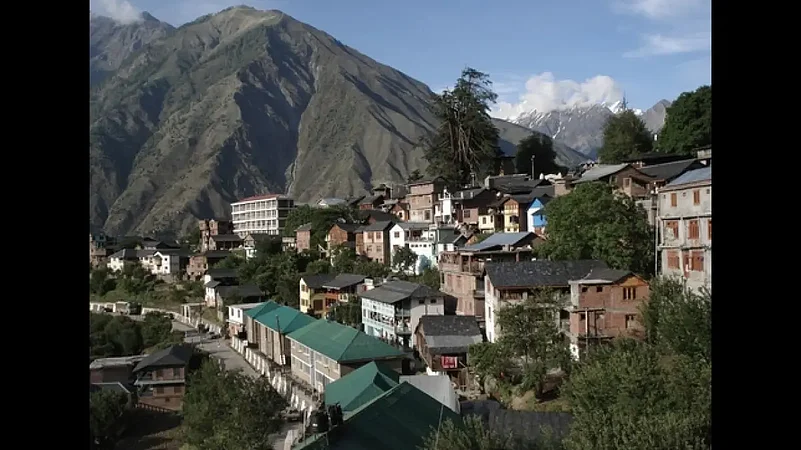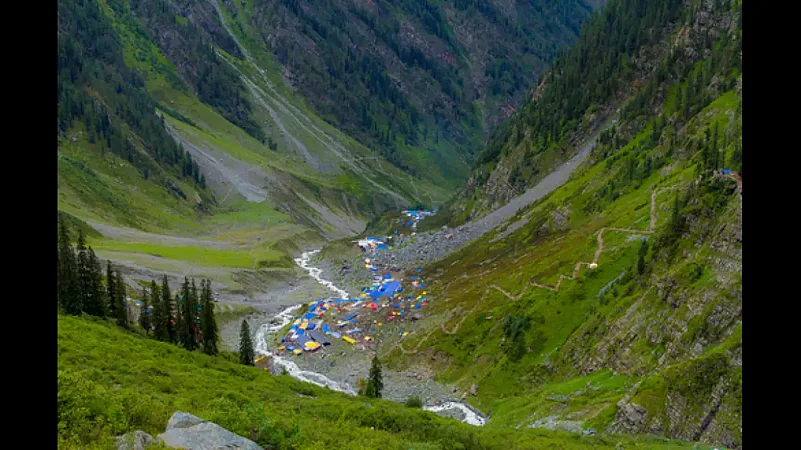The monsoon rain unleashes its watery load over the mountains, the springs and rivers overflow, a landslide or two is not uncommon. But nothing can deter the pilgrims from continuing with their journey. They are on their way to take a holy dip in the glacial lake (perched at over 13,000 feet) which lies at the foothills of the Manimahesh Kailash peak (18,546 feet) deep inside the northern Indian state of Himachal Pradesh. Usually, the lake remains frozen for the greater part of the year, and it is only after the snow melts in summer that the trail is revealed. The festival, known as the Manimahesh Yatra, is dedicated to Shiva. It usually starts on Janmastami (when the rest of the country is celebrating the birthday of Krishna) and concludes on the day of Radhastami.
Advertisement

Bharmour, a small town, about 64km away from Chamba, is the gateway to Manimahesh. The town itself is a picturesque place, surrounded by the Pir Panjal and Dhauladhar ranges. The chhari yatra starting from Chamba town marks the beginning of the festival when priests and pilgrims carrying the staff with the sign of Manimahesh, the trident and oher holy objects symbolically associated with Shiva set off in a procession.
Although the origin of the yatra is not very clear, it is said that the local Gaddi tribe has been worshipping the Manimahesh peak as the abode of Shiva since time immemorial. According to local lore, Manimahesh means the ‘jewel of Shiva’. Apparently, on a clear day, the peak dazzles like a diamond under the dawn lit sky. The meadow at the base of the hills is called the chaugan of Shiva.Innumerable legends surround this peak. The smaller peaks below the main peak are said to be a shepherd and his flock of sheep frozen to stone by divine wrath for disobeying a rule that forbade anyone from climbing the sacrosanct peak. Another tale talks of a snake which had been similarly frozen.
Advertisement
The motorable road goes up to Hadsar (about 12km from Bharmour).But the final 13 km (approximately) to the lake has to be covered on foot, part of it through some very rough terrain. If you are in a hurry, there is a heli-taxi service from Bharmour. Many pilgrims stop at Dhanchho, a village between Hadsar and Manimahesh, to spend the night, before proceeding to the Manimahesh Lake. The waterfall at Dhanchho is a must see. According to local customs, men and women stop at the lakes named Shiva Krotri and Gauri Kund, respectively, for a bath, before proceeding to Manimahesh. Here they offer prayers at the idol of Shiva after the dip in the lake.

Even if you are not spiritually inclined, visiting the Manimahesh Lake during the yatra is likely to be a rewarding experience if you are interested in photography and local culture. The meadows on way to the lake are often home to various alpine flowers. On a fair day, you will catch the reflection of the snow peaks in the blue waters of the oval shaped glacial lake.
After a visit to the lake, you may spend a couple of days, enjoying the scenic beauty and the architectural legacy in and around Bharmour and Chamba.
Advertisement
The Chaurasi temple square in Bharmour encloses 84 shrines built between the 7th -10th centuries. The temple of Bharmani Devi stands on a steep forested slope, about 4km from town. Weather permitting, you may go an excursion to Salooni (56km away) and to the Bhandal Valley (22km from Salooni). The region is known for a sweeping view of the snow peaks and the alpine flora and fauna.
Besides its natural beauty, Chamba is a repository of local art and architecture. The town sprawls along the bank of the Ravi River. The Lakshmi Narayan temple is the oldest temple of the group of six stone temples depicting the 8th century shikhara style of architecture. The Bajreswari temple is another temple with fine carvings. The 11th century Hari Rai Temple contains a finely crafted four-armed bronze statue of Lord Vishnu. The Chamunda Devi temple, away from the town centre, is noted for its woodwork. Chamba is one of the places that fostered the Pahari School of miniature painting. A visit to the Bhuri Singh Museum closed on Mondays and other holidays) will acquaint you with these local arts. A must buy in Chamba is the exquisitely embroidered ‘rumal’ (scarf).
Advertisement
Information: The Manimahesh Yatra in 2022 is scheduled to be held from August 19 to September 2. According to local media reports, those visiting Manimahesh during the yatra period this year have to mandatorily register themselves with the local administration and pay a per head fee of Rs 20. The route through Kugti will not be opened for the yatra this year, reports said. It is better to acquaint yourself with the latest health related rules by contacting Himachal Pradesh Tourism offices before planning.
By road, Chamba, the most convenient gateway for Manimahesh, is about 120km from Pathankot, which is also the nearest rail head and airport. Gaggal airport in Kangra is about 150km by road from Chamba. There are hotels in Chamba and Bharmour, including HPTDC tourist lodges in Chamba and Bharmour. Accommodation in Dhanchho is basic at best.
Advertisement
This year, according to media reports, the administration has approved heli-taxi service by two private companies; these will be available between August 12 and September 2, between Bharmour and Gaurikund.




















